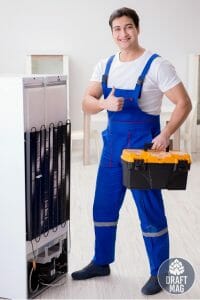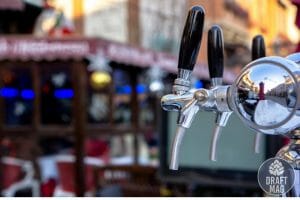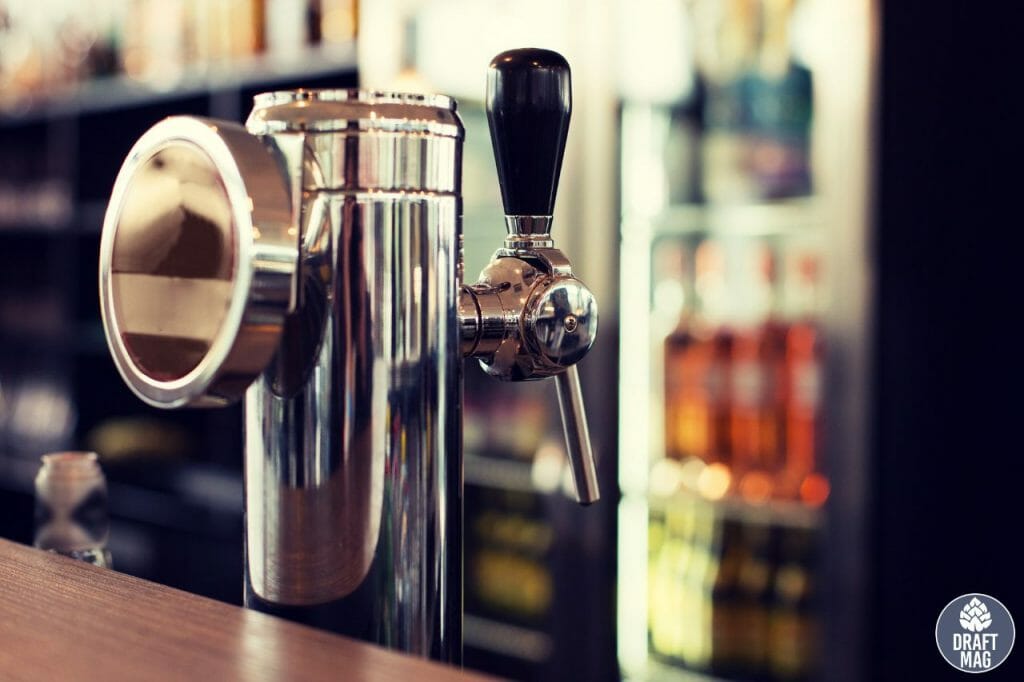DIY Kegerator: How To Build Your Own Kegerator at Home the Easy Way
 A DIY Kegerator is a beer dispenser designed to keep your beverage chilled at all times. You can buy a ready-made kegerator, but they are pretty pricey.
A DIY Kegerator is a beer dispenser designed to keep your beverage chilled at all times. You can buy a ready-made kegerator, but they are pretty pricey.
Luckily, you can avoid that high price by building your own as long as you can commit a few hours and gather all the tools needed.
In this article, our experts have curated an easy step-by-step guide on how to build a kegerator for beginners and experts alike.
How To Build a DIY Kegerator
– Choose Your Refrigerator
The primary item of your project, of course, is a fridge. As previously explained, your kegerator is simply a dispenser that doubles as a refrigerator. The word “kegerator” is a clever combination of the words “ keg” and “refrigerator.” You’ll need to choose a refrigerator to convert into a kegerator to start.
There are three types of fridges that you can choose from, and each of them has its advantages and disadvantages. Let’s look at them in detail.
Mini-fridge
The first is a mini-fridge, one of the most commonly used fridge types for kegerators. This is mostly because they are small and compact and, as such, use less power and take up less space. Their most common disadvantage is their size. Not all models can fit multiple kegs of larger kegs.
Mini-fridges can also provide more versatility as you can mount faucets on top of the fridge instead of the sides of the door. That way, you’ll have more dispensing options than you typically would with most other fridges. You can find used models of mini-fridges to convert at affordable prices.
Standard Fridge
A standard fridge is a full-sized refrigerator that will take up more space. They’re also great for building a kegerator, and you’ll never have to worry about your legs not fitting in it. You can also put multiple kegs in them. The only downside to converting a standard fridge is that it will use a lot of power and take up a lot of space.
Chest Freezer
You can also go for the largest option: a chest freezer. When converted, you could also call this chest freezer kegerator “keezers.” People prefer freezers because they give a lot more storage space than any other refrigerator, and they are better insulated.
If you’re looking to serve a large group of people or you’re looking to serve different types of beer, a freezer would be the perfect fridge for your kegerator. Take note that using a freezer will cost you more as the keezer build will take up a lot of power.
– Choose Your Kegerator Conversion Kit
 You will need a kegerator conversion kit to make your kegerator project significantly easier. Once you’ve chosen the fridge you want to convert, you can select the kit you’ll use for the build.
You will need a kegerator conversion kit to make your kegerator project significantly easier. Once you’ve chosen the fridge you want to convert, you can select the kit you’ll use for the build.
This kit is vital in assembling the dispensing part of your kegerator. It helps you dispense beer through the refrigerator door and, if you decide otherwise, from a tower on your countertop.
Many kits on the market have different features — different numbers of taps, tank sizes, tap towers, regulators, drip trays, etc. The general rule of thumb is to choose the kit to match the type of fridge you have picked.
Most kits are made for entry-level homemade kegerator builders and will likely have low-quality items that will not last long. If you need something more durable, you’ll have to watch out for kits with all the basic items in good quality. There are different types of kegerator conversion kits and what you choose depends on the type of fridge you have, how you want to serve your beer, and sometimes, even the type of beer you’ll be serving.
Door Mount Conversion Kits
Door Mount Conversion Kits help you mount your faucet on the door of your fridge to dispense beer. These are the most common ones used as they are easy to install and allow easy access to the storage in your fridge. You could have extra cans, bottles, and other drinks stored in the fridge and would need easy access to reach them at all times.
You can also use this kit to make a stationary or portable kegerator. You can do this by simply adding mount casters on the refrigerator, so it’s best if it’s a small fridge, and you’ll have a portable kegerator that you can move around your home.
Tower Kits
Tower kits are perfect if you have a larger fridge. They work best for built-in kegerators as the faucet is mounted on top of a counter while the fridge is stored below. Although tower conversion is much more difficult, they look more professional and neat as the kegs are stored in a cabinet, out of sight.
The downside to this is that you will have to cut a hole in your countertop to make room for the faucet, the gas lines, and the beer lines. This kit would be easier to work with if you have a home bar. Although they have their own specialized keezer conversion set, freezers are most commonly converted using tower kits.
Inclusions
Most conversion sets include:
- Beer line
- Air tank
- CO2 pressure line
- Stainless steel barrel
- Shank
- Regulator
- Keg coupler
- Beer faucet
- Faucet lock
- Tap handle
- Drip trays
– Disassemble the Fridge
 To begin your step-by-step kegerator plans, ensure that your fridge is unplugged. Next, you’ll need to disassemble it. Unscrew the screws in front of the assembly and take out the one on the back. Pull down the whole assembly and unscrew the refrigerator’s door, removing all the loose plastic shelving compartments.
To begin your step-by-step kegerator plans, ensure that your fridge is unplugged. Next, you’ll need to disassemble it. Unscrew the screws in front of the assembly and take out the one on the back. Pull down the whole assembly and unscrew the refrigerator’s door, removing all the loose plastic shelving compartments.
They will take up space and interfere with closing the door properly when the kegs are installed. Remember that you’ll need as much room as you can get for your kegs.
– Remove the Plastic Top Piece
Depending on the type of fridge you’re working with, there’s likely a plastic piece on the roof of the fridge. The lid is either going to be screwed in place or glued on. If it’s screwed on, unscrew the screws and remove the plastic top piece. It might be impossible to pull it off with just your hands if it’s glued on.
Work a thin spatula under the lid and start prying it open. You may use a hammer to gently tap the plastic piece’s bottom. Work your way around the piece until it starts to lift. This could take a while, but the lid will gradually peel off when it does.
– Find the Cooling Lines
Sometimes, cooling lines run across the top or the bottom of the fridge, and in some refrigerators, they may run vertically on the sides to keep the compartments cool. You’ll need to carefully approach the cooling lines as one cut kills the fridge immediately.
Trace the point where the lid was in contact with the cooling lines as the lid probably left indentations on the insulation. If you can’t locate any markings, intuitively pick out the spot you want to install your tower and use a spatula to dig through the insulation. Ensure that the hole you make is as centered as it can be.
– Drill a Hole in the Fridge
The next step involves drilling a hole into your fridge for the liquid lines and cooling line you will install later. To avoid scratching the top, use masking tape to cover the area you’ll be drilling.
Make a mark in the center of the area where you’ll be drilling between the delicate cooling lines. Drill the hole starting at the top and work your way down. Drill through the plastic top, white foam board, steel sheet, insulation foam, and white plastic sheet. You will most likely encounter difficulties cutting through the steel, so use a good hole saw.
– Prepare the Lid
You’ll need to support the plastic lid with plywood as the stainless-steel tower will be too heavy. Break off the ridges beneath the lid and file them down to help the plywood sit flush against the plastic lid. Locate the center of the spot using the ridges and drill a small pilot hole there.
– Make Room for the Plywood
Measure your thick plywood with the dimensions 9.25 x 6.5 inches (this may vary based on your materials), and then trace its shape against the insulation surrounding the hole you drilled. Cut out some insulation until the plywood lays flat on the top.
– Install the Plywood and Mark It for Drilling
Reinforce your lid with the plywood and temporarily return it to its position. Mark the spot where you will drill out the plywood using the pilot hole you drilled in Step 7.
– Drill the Lid and Plywood
 Now that you know where to drill, remove the lid and plywood and use a hole saw to drill a hole through the plywood. Don’t forget to remove them so that you don’t puncture the cooling lines while drilling. Make sure that it’s exactly where the marking is — lined up with the plywood and the fridge — and that it’s at the center of the lid.
Now that you know where to drill, remove the lid and plywood and use a hole saw to drill a hole through the plywood. Don’t forget to remove them so that you don’t puncture the cooling lines while drilling. Make sure that it’s exactly where the marking is — lined up with the plywood and the fridge — and that it’s at the center of the lid.
– Install a PVC Conduit
Connect the bottom hole of the tower and insulate the conduit beneath the plywood using a 2.5-inch wide PVC pipe with moisture-resistant aluminum tape. Cut the PVC piping short, so it doesn’t bear the tower’s weight as it sits right above the cooling lines. Slightly angle the conduit so it’s aligned with the oblong hole in the refrigerator.
– Install the Tower and Rails on the Lid
The tower is attached to the base with four screws. Drill pilot holes through the lid and the plywood below for each screw, then install the screws. If you feel like taking the extra step, buy some stainless-steel cabinet drawer pulls to add a stylish touch to the top of the fridge.
– Relocate the Thermostat and Light
If you plan to fit more than one keg in your kegerator, you’ll need to make some room. Locate the thermostat and light and move them further back to clear some space. This might not be necessary if you’re using a single keg.
– Construct the Tower Cooling System
As the refrigerator does its job of cooling your kegs, air exchange occurs within it such that cool air sinks and hot air is elevated. The hot air settling above will start warming up the beer lines, and you’ll need to cool it down to avoid dispensing foaming beer.
This is where a tower cooler with a working fan comes in for temperature control, as this is used to circulate chilled air from down the fridge and up the beer tower.
– Add a Fan Box
The fan box will house cables and other tubes that come and go to the tower cooler. Don’t worry too much about how clunky it might look, as the fan box will be buried beneath the kegs. Drill three holes in the container: one for the fan, one for the tube that will pass the air to the tower cooler, and one small one for the power cable.
– Power the Fan
If you have a power cord lying around or bought one for this DIY, simply cut off the end of the plug, strip its wires, and twist them into connection with the fan’s wires. The connection map is black to black and red to white. Use a crimp to reinforce this connection.
– Install the Fan Box and Reattach the Lid
Create a connection between the tower and the cooling box on the fridge’s compressor hump using a 1-inch-wide vinyl hose. Slip the power line through the drainage hole in the back of the fridge.
When it starts running, the fan from the tower cooler will draw air from the bottom of the fridge and push it up through the vinyl tube and into the tower. This will cool the beer lines and prevent foaming. After installing the cooling system, return the lid and reattach it using silicone caulk.
Fill up the space surrounding the PVC pipe with a Great Stuff window and door insulation foam sealant to form airtight and water-resistant seals within your kegerator’s structure. You can use any sealant foam as long as it works straight and doesn’t expand excessively.
– Reattach the Door
It’s finally time to wrap things up. Reattach the door and hook up your fresh kegs and CO2 tank. Congratulations! Now you can enjoy a cold beer in the comfort of your own home or wherever else you choose.
How To Choose a Refrigerator for Your Kegerator
When choosing a refrigerator for your kegerator, it’s important to remember that not every refrigerator will work for conversion into a kegerator. Some of them are built so that conversion, drilling, or modifying is impossible. There are a few factors to consider when choosing a fridge for your kegerator. These include:
– Size
 The fridge must have enough room for the number of kegs you want to put in your kegerator. It also needs to be big enough to store the coupler on top of the key and the beer lines. Mini-fridges come in various sizes, with small fridges measuring 17 inches wide, 18 ⅞ inches deep, and 20 inches tall.
The fridge must have enough room for the number of kegs you want to put in your kegerator. It also needs to be big enough to store the coupler on top of the key and the beer lines. Mini-fridges come in various sizes, with small fridges measuring 17 inches wide, 18 ⅞ inches deep, and 20 inches tall.
Larger refrigerators can be up to 19 inches wide, 20 inches deep, and 43 inches tall. The general/average height required for interior height is 28 inches. Dorm refrigerators, in general, do not have the space for even a pony keg, nor do they have the cooling power to keep a keg cold enough.
If you decide to use a tall refrigerator with a good compressor, keep in mind that in addition to the height of the pony keg, you will also need to account for the height of the coupler. Make sure you measure everything twice so that when you’re converting, drilling, and cutting, you don’t make any mistakes that could damage the fridge.
– Position of Refrigeration Lines
You’ll probably find older fridge models if you’re buying a used refrigerator. Many older refrigerators were built with “cold wall” designs, which means that the refrigeration lines run the length of the fridge’s case. You’ll need to drill holes through the case and risk puncturing the refrigeration lines running through it. Hence, such fridge designs aren’t suitable for kegerator conversion.
– Compressor Capacity
The first factor to consider when selecting a refrigerated compressor is the refrigeration capacity you will need. In simple terms, this is how cool it gets. Compressors come in different operation ranges, so there are many options.
Basically, you need a compressor that is strong enough to keep your beer kegs sufficiently cool and nothing more. A one-fifth HP appliance is best recommended to sufficiently cool your beer.
– Accessibility
Before choosing a fridge, you’ll need to decide where you want your faucets to be — on the sides or on top. You’ll also have to consider the height of your faucet tap handle. This is important since you do not want your tap handle to obstruct your entrance into the fridge to reach your kegs or any other thing you may have stored, such as cans or other beverages.
The ideal pouring height will vary for each fridge, so you’ll decide what height is most convenient.
– Used or Brand New
Most people who build custom kegerators go for used refrigerators. This is because it’s much cheaper to get a fridge that someone needs to let go of rather than buy a new one.
The downsides of buying a used fridge for your kegerator are that their compressors are quite worn, inefficient, and often poorly insulated with many airspaces. Consider buying a brand new fridge if you want to splurge and build a kegerator that will last longer.
How To Choose the Correct Keg Type
 Before building your kegerator, decide the types of kegs you’ll use for your beer and what sizes you’ll buy them in. To make the most of your kegerator, you should know about the different keg types and sizes offered on the market today.
Before building your kegerator, decide the types of kegs you’ll use for your beer and what sizes you’ll buy them in. To make the most of your kegerator, you should know about the different keg types and sizes offered on the market today.
The different types and sizes of kegs have their unique purposes and can be used in different situations with different types of kegerators. The most common keg types are:
– Cornelius Keg
The Cornelius keg was originally designed to store and dispense soda like Coke and Pepsi, and in a lot of places, it still serves that function. Homebrewers also use this keg as an alternative to having beer in cans or bottles.
The corny key is large enough to store 5 gallons of beer (40 pints), about the typical amount of beer in a batch of homebrew. Homebrewers especially love the Cornelius keg because it is easy to fill up, clean, and maintain.
You can easily open the top to clean it out without special tools. An empty Corny keg weighs 10.5 pounds, and when filled up, it weighs 55 pounds. This keg type is best suited for bars that don’t have a lot of traffic, or for smaller events where you don’t need to serve a lot of beer. Corny kegs typically have two main connector types — the older models often use pin-lock, while newer models have ball-lock connectors.
– Sixth Barrel Keg
Sixth Barrel Kegs are also referred to as sixtels and are the second smallest common keg type. This keg looks like Corny Keg, but it only has a slightly larger capacity than the Corny keg. While the latter has a 5.0-gallon capacity, the sixtel holds 5.16 gallons or 41 pints. Corny Kegs has a pin-lock or ball-lock connection, but the keg has a standard keg valve system.
This valve system is trickier to use as you’ll need a coupler to dispense beer. Most beer lovers who use sixth barrel kegs prefer them because they are the perfect size to fit inside a regular kegerator cabinet.
Hence, the Sixth Barrel Keg is widely utilized in dual or 3-tap kegerators. The keg size is perfect for small businesses, pubs, and households. The major disadvantage to buying a sixtel keg is its challenging maintenance. Most homebrewers prefer Cornelius kegs over the Sixth Barrel as this one requires you to use special equipment to open and clean it.
– Quarter Barrel Keg
The Quarter Barrel Keg is a funny-looking sort of keg. It has a short appearance and looks like it can’t hold much. On the contrary, this keg is much larger in capacity than both the Sixth Barrel and Corny kegs.
The Quarter Barrel keg holds 7.75 gallons of beer (62 pints) and is a great option for small gatherings, single and dual tap kegerators, and limited space. The short, stubby shape enables you to stack many quarter barrels on top of each other if you’re short on storage space. You will not be able to tap all the kegs at once, but you will be able to maximize your space and keep things organized.
– Slim Quarter Keg
Sometimes called the Tall Quarter or The Slim, the Slim Quarter Keg looks like a slimmer version of the Quarter Barrel, and they hold about the same amount. The Slim Quarter keg’s slim shape makes it the perfect choice for dual-tap kegerators, allowing you to serve different beverages at once.
With a capacity of 7.75 gallons (62 pints), the Slim is most commonly used in small gatherings, limited spaces, and with single to triple-tap kegerators.
– Half Barrel Keg Size
This is the normal, traditional full-sized keg you may have seen around. It is perfect for everything from large gatherings to commercial use and large homebrew. This huge keg, commonly used in bars, holds 15.5 gallons (124 pints) and fits into the usual standard-sized home kegerators. The Half Barrel keg is easy to clean and typically uses a Ball Lock.
It’s most common to hold big beverage batches for homebrewers who brew in large batches. The Half Barrel keg will do nicely rather than splitting your batches into 5-gallon Corny Kegs. If you’re just starting out with homebrewing or trying out a new recipe, you may want to go with a smaller keg size.
– 50 Liter Keg
Mostly found in European breweries, the 50 Liter keg is much like the European version of the American Half Barrel keg. This keg is the most common keg size in European countries and is similar in shape and size to the Half Barrel. While the Half Barrel has a larger capacity, the 50-liter keg has a capacity of 13.2 gallons (105 pints). If you get your hands on the import kegs, know that they will require couplers, but don’t use a standard US Sankey D coupler.
Before buying this keg size, ensure that your kegerator is large enough to store it — they’re mostly used with single tap kegerators. The 50-liter keg is most commonly used at large events, businesses, and European commercials.
– Mini Keg Size
A mini-keg resembles a little barrel and is an excellent choice for a small gathering of friends where you would ordinarily bring a 12-pack. The small keg contains around 10 pints in its 5-liter capacity.
It’s not easy to come by these keg sizes because they are imported. They’re usually Heineken micro kegs, which feature a CO2 canister to pour the beer.
There isn’t a huge range of small kegs. However, depending on where you live, you can buy a few more imports (ex., Warsteiner, Bitburger) and craft beers (ex., Bell’s Oberon Ale & Hopslam). To let air into these tiny kegs, you open the bung at the top and then dispense the beer through the faucet at the bottom.
How To Build a Beer Kegerator Tower Cooler
 A Beer Tower Cooler keeps the beer chilled while it sits in the tower by circulating chilled air from your refrigerator up to the DIY draft beer tower. The tower cooler’s fan box unit fits neatly inside your refrigerator or kegerator, taking very little space. Without a good tower cooler, your kegerator will dispense foamy beer for the first and sometimes second glass, forcing you to return a second time to get a good pour.
A Beer Tower Cooler keeps the beer chilled while it sits in the tower by circulating chilled air from your refrigerator up to the DIY draft beer tower. The tower cooler’s fan box unit fits neatly inside your refrigerator or kegerator, taking very little space. Without a good tower cooler, your kegerator will dispense foamy beer for the first and sometimes second glass, forcing you to return a second time to get a good pour.
The items you will need are a plastic box enclosure of the right dimensions, a power jack, a micro fan, a power adapter with the correct plug dimensions, cable ties, clear vinyl tubing, CPVC Bushing, aluminum rivets, and aluminum flat washers. If you can’t get rivet and washers, you can use screws and nuts instead. Take note that you can’t use a USB power supply for your kegerator tower cooler.
– Drill Mounting Holes for Your Fan
Ensure that the holes are the same size as the rivets or half the size if you plan to use 6 x 32 screws. The holes you drilled should align perfectly with the fan body’s mounting holes if you do it right.
– Drill the Hole Through Which the Fan Will Draw Air
Measurements may vary, but ensure that the opening you make is large enough for the fan to draw air through it and is centered between the two mounting holes. Clean up any stray plastic by shaving it off with a pocket knife.
– Drill the Power Jack Hole
Drill a hole for your jack and ensure it is the right size.
– Drill a Hole for the CPVC Bushing
The CPVC bushing should fit into the hole without pushing all the way through. The ledge on the back of the bushing will stop it from pushing through.
– Mount Your Cooling Fan Motor
Position the fan motor on the rivets such that the fan draws air into the housing from the outside and not the other way around. If you mount the motor backward, it will be damaged when you turn it on.
Put backup washers on top of the rivets so that they do not damage your motor housing. Hold the fan in place and rivet it.
– Mount the Power Jack
Keep the pins within reach as you’ll need to solder them later.
– Solder the Fan Wires to the Power Jack
Before you begin soldering, ensure that the fan wires are the exact length you need. Trim them if they’re not and strip off the insulation at the end of the wires. Locate the correct pins on the power jack and start soldering.
You will need to cut off the yellow wire if your fan comes with black, red, and yellow wires. Ensure that you’re using electronic solder as the flux will eat your wires.
– Test Run Your DIY Tower Cooler Fan
Plug it in and see if it will turn on. If it doesn’t, give it a kickstart by spinning the fan with your hand. If that works, you’ll need to go back in and fix the air hole — there’s probably a piece of plastic that you need to trim.
This might also be the case if the fan turns on but makes a weird vibration or buzzing sound. If the fan doesn’t turn on at all, that’s likely a problem with your wiring and soldering.
– Put the Air Tube Together
The air tube will reach into your beer tower through the hole you drilled in step 4. Fit the CPVC bushing into the hole from outside and turn it over flat against a counter or any hard surface, so you have something to push against while fitting the tube.
Force the plastic tubing over the bushing and if the tube is too hard to fit over the bushing, soften it by dipping it in hot water for a few seconds.
– Assemble the Tower Cooler
Now that everything is in place, join the two halves of your tower cooler and install them into your kegerator beer tower. Install it by pushing the end of the hose upwards until it’s flush against the beer shank in the beer tower. Tie the hose to the beer line with wire and run the power cord through a hole in the back of the kegerator.
Plug it in and you’re good to go.
FAQs About Building Kegerators
– How Much Does It Cost To Make Your Own Kegerator?
It could cost you between $300 to $600 worth of materials, a few hours of labor, and some basic DIY skills to make your own kegerator. This figure varies depending on the materials you already have, the cost of resold items, and your location. Homebrewers have been customizing tiny refrigerators and freezers for years to create the at-home bar of their dreams for a lower cost.
Aside from this, a kegerator with draft towers normally requires one to two beer lines as well. You will need around 8 feet (from the top of the keg to the faucet tap) if you want to use a 3/16-inch inner diameter beer line for dispensing a keg at 10 PSI of pressure. Beer lines usually come in either ⅜-inch inner diameters or 3/16-inch inner diameters. ⅜-inch lines give a better flow rate with lower pressure requirements.
The best and most common places to buy kegerator parts include kegkits.com, Amazon, Kegconnection.com, CHI Company, Kegworks, and Micromatic.
– Do You Need CO2 for a Keg?
Yes, you will need CO2 for your kegerator. You can get your CO2 tank refilled at local welding supply stores, fire extinguisher filling stations, homebrew shops, and sports goods stores that offer paintball weapons.
Conclusion
It’s a great big world filled with all kinds of beer to explore, and we’re simply here to enjoy them. Building a kegerator can be a fun way to tailor your servings to suit your needs and lifestyle. Before you start building, here’s a recap of the article above:
 First, choose the type of refrigerator you want to convert, get a premade kit, and disassemble the fridge.
First, choose the type of refrigerator you want to convert, get a premade kit, and disassemble the fridge.- Carefully deconstruct the fridge and make room for the kegerator fixtures such as the PVC conduit, the tower, tower cooling system, and fan box.
- Relocate the thermostat and light.
- Install the fan box and reassemble the fridge.
- Reattach the door and do a test run.
After reading this complete guide, you should now have a fully functioning kegerator, so invite some friends and enjoy your new kegerator today!

 First, choose the type of refrigerator you want to convert, get a premade kit, and disassemble the fridge.
First, choose the type of refrigerator you want to convert, get a premade kit, and disassemble the fridge.




